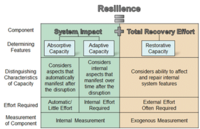-
A grid of the right size could reduce blackout risk
Scientists argue that for every animal there is an optimal size — one which allows it to make best use of its environment and the physical laws that govern its activities, whether hiding, hunting, hoofing, or hibernating. Now, researchers are asking whether there is a “right” size for another type of huge beast: the U.S. power grid. The researchers believe that smaller grids would reduce the likelihood of severe outages, such as the 2003 Northeast blackout that cut power to fifty million people in the United States and Canada for up to two days.
-
-
Bangladesh tops list of countries at risk from sea level rise
Scientists say that see levels may rise by up to the feet by 2100.The implications of this would have drastic consequences for nearly all coastal nations, but the consensus is that Bangladesh will be the hardest hit by the change. Leading Bangladeshis say that since Bangladesh produces less than 0.3 percent of the emissions driving climate change, it would unjust for Bangladesh to rely on its own meager resources to solve this problem. One solution they offer: fifty million Bangladeshis (out of a population of 163 million) should be allowed to move to and resettle in the countries which produce the bulk of greenhouse gasses.
-
-
Coalition sounds alarm about possible global EMP disaster
A coalition that includes former speaker of the House Newt Gingrich and former CIA director James Woolsey has issued a terse warning regarding apocalyptic effects that could result from a mass EMP (electromagnetic pulse) disaster or attack. Members of the coalition “are convinced that our fragile electrical grid could be wiped out at any moment” from bursts of electrical energy caused by anything from a nuclear explosion to a solar flare from the sun, leading to chaos on a global scale.
-
-
Capabilities-based – rather than actuarial -- risk analysis would make businesses safer
Many businesses and organizations, when applying cost-benefit analysis and a risk-management analysis to measure cyber risk, are relying on the assumption that the likelihood of a future attack depends heavily on how many attacks have occurred in the past. Since there has yet to be a full-scale attack on critical infrastructure in the United States, it is simple to conclude that the risk of a cyberattack on critical infrastructure is low, therefore justifying low investment in additional security initiatives. An actuarial risk analysis may conclude that there is little likelihood of such as attack occurring, but a capabilities-based risk analysis recognizes that since adversaries are capable of such an attack, it is in an organization’s best interest to secure against it.
-
-
Sandia to help cities be better prepared for, emerge stronger from, disasters

Sandia National Laboratories says it will bring its experience solving problems with practical engineering and modeling complex systems to cities around the world under a new agreement to support the 100 Resilient Cities Centennial Challenge, pioneered by the Rockefeller Foundation. The challenge, which will help thirty-three cities in its first year, seeks to make communities more resilient by being better prepared to withstand natural or manmade disasters, recover more quickly, and emerge stronger.
-
-
Roadmap outlines R&D path to reduce storm impacts
A new measurement science research and development (R&D) roadmap, prepared for the National Institute of Standards and Technology (NIST) over the past two years by a private-sector group of hazard mitigation experts, provides a broad strategic approach and R&D objectives to reduce impacts from windstorms and coastal inundations, including storm surge during hurricanes and tsunamis.
-
-
Friday L.A. tremor harbinger of quake worse than the Big One

Seismologists warn that a bigger earthquake along the Puente Hills fault, which produced the 5.1 magnitude tremor in Los Angeles last Friday, could cause more damage to the region than the anticipated “Big One” from the San Andreas Fault located on the outskirts of metropolitan Southern California. A 7.5-magnitude earthquake along the Puente Hills fault could kill 3,000 to 18,000 people and cause up to $250 billion in damages, leaving up to 750,000 people homeless. In contrast, an 8-magnitude earthquake along the San Andreas Fault would result in about 1,800 deaths.
-
-
Using more wood for construction will reduce reliance on fossil fuels
A new study has found that using more wood and less steel and concrete in building and bridge construction would substantially reduce global carbon dioxide emissions and fossil fuel consumption. Despite an established forest conservation theory holding that tree harvesting should be strictly minimized to prevent the loss of biodiversity and to maintain carbon storage capacity, the study shows that sustainable management of wood resources can achieve both goals while also reducing fossil fuel burning.
-
-
Delaware launches cyber initiative
Delaware is joining the number of states that have decided to invest in a statewide cybersecurity workforce to combat the growing threat of cyberattacks directed at both private and public institutions.Delaware hopes its cyber initiative will accelerate current efforts to develop a stronger cyber workforce. The Delaware Cyber Initiative proposes $3 million for a collaborative learning and research network in the form of part research lab, part business park, dedicated to cyber innovation.
-
-
Quantum mechanics may lead to ultra-secure Internet
In 1935 Einstein and researchers highlighted a “spooky” theory in quantum mechanics, which is the strange way entangled particles stay connected even when separated by large distances. In the 1990s, scientists realized you can securely transmit a message through encrypting and using a shared key generated by Einstein’s strange entanglement to decode the message from the sender and receiver. Using the quantum key meant the message was completely secure from interception during transmission.
-
-
Conflicting views hamper N.C. preparation for sea level rise
Residents of North Carolina’s coastal towns are finding themselves increasingly caught in the cross-fire between local and state government regarding how to define future sea level rise resulting from global warming and the necessary measures needed to prepare for it. Due to a four-year moratorium on any action on the state level, area developers and homeowners have received no official input, and the lack of consensus has negative consequences for the health and prosperity of the region.
-
-
Making the grid smarter makes it more vulnerable to hackers
The U.S. electric grid is constantly under attack despite attempts by utilities to boost physical security and cyberdefenses. In 2013 a DHS cyber emergency team responded to more than eighty incidents involving energy companies. “If you’re a utility today, depending on your scale, you’re under attack at this moment,” says Robert Weisenmiller, chairman of the California Energy Commission.
-
-
Iran becoming serious cyber-warfare threat
Both government and private cybersecurity experts are increasingly considering Iran as a “top ten” cyberthreat. Iran’s recent activities and its motives have led analysts to rank the country among other cyberspace heavy hitters such as Russia and China.
-
-
Ground-improvement methods to protect against earthquakes
Researchers are developing ground-improvement methods to help increase the resilience of homes and low-rise structures built on top of soils prone to liquefaction during strong earthquakes. Findings will help improve the safety of structures in Christchurch and the Canterbury region in New Zealand, which were devastated in 2010 and 2011 by a series of powerful earthquakes.
-
-
Climate change, population pressures leading to rethink of floating cities

The concepts have existed for decades, but governments and financiers, responding to the growing threat of rising tides, pollution, and overpopulation to coastal urban centers, are now beginning to take a more serious look at floating cities.
-
- All
- Regional
- Water
- Biometrics
- Borders/Immig
- Business
- Cybersecurity
- Detection
- Disasters
- Government
- Infrastructure
- International
- Public health
- Public Safety
- Communication interoperabillity
- Emergency services
- Emergency medical services
- Fire
- First response
- IEDs
- Law Enforcement
- Law Enforcement Technology
- Military technology
- Nonlethal weapons
- Nuclear weapons
- Personal protection equipment
- Police
- Notification /alert systems
- Situational awareness
- Weapons systems
- Sci-Tech
- Sector Reports
- Surveillance
- Transportation
Advertising & Marketing: advertise@newswirepubs.com
Editorial: editor@newswirepubs.com
General: info@newswirepubs.com
2010-2011 © News Wire Publications, LLC News Wire Publications, LLC
220 Old Country Road | Suite 200 | Mineola | New York | 11501
Permissions and Policies
Editorial: editor@newswirepubs.com
General: info@newswirepubs.com
2010-2011 © News Wire Publications, LLC News Wire Publications, LLC
220 Old Country Road | Suite 200 | Mineola | New York | 11501
Permissions and Policies
